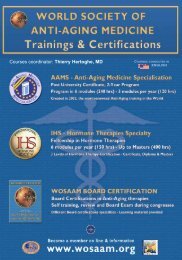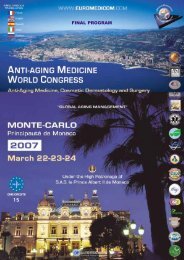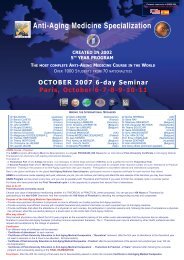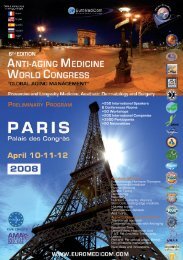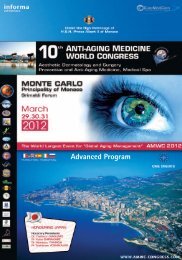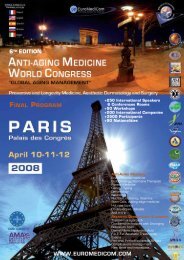FINAL PROGRAM 6TH EDITION - EuroMediCom
FINAL PROGRAM 6TH EDITION - EuroMediCom
FINAL PROGRAM 6TH EDITION - EuroMediCom
Create successful ePaper yourself
Turn your PDF publications into a flip-book with our unique Google optimized e-Paper software.
failure in elderly individuals without a previous myocardial infarction: the Framingham Heart Study. Ann Intern Med. 2003 Oct 21;139(8):642-8.14. Jankowska EA, Biel B, Majda J, Szklarska A, Lopuszanska M, Medras M, Anker SD, Banasiak W, Poole-Wilson PA, Ponikowski P. Anabolicdeficiency in men with chronic heart failure: prevalence and detrimental impact on survival. Circulation. 2006 Oct 24;114(17):1829-37.15. Denti L, Annoni V, Cattadori E, Salvagnini MA, Visioli S, Merli MF, Corradi F, Ceresini G, Valenti G, Hoffman AR, Ceda GP. Insulin-like growth factor1 as a predictor of ischemic stroke outcome in the elderly. Am J Med. 2004 Sep 1;117(5):312-7.Increased risk of cancer in people with lower serum IGF-1 levels within reference range16. Lönn S, Inskip PD, Pollak MN, Weinstein SJ, Virtamo J, Albanes D. Glioma risk in relation to serum levels of insulin-like growth factors. CancerEpidemiol Biomarkers Prev. 2007 Apr;16(4):844-6. Radiation Epidemiology Branch, Division of Cancer Epidemiology and Genetics, National CancerInstitute, Room 7053, 6120 Executive Boulevard, Bethesda, MD 20892-7238, USA. Lstefan@mail.nih.gov17. Agurs-Collins T, Adams-Campbell LL, Kim KS, Cullen KJ.Ins ulin-like growth factor-1 and breast cancer risk in postmenopausal African-Americanwomen. Cancer Detect Prev. 2000;24(3):199-206.18. Fuhrman B, Barba M, Schünemann HJ, Hurd T, Quattrin T, Cartagena R, Carruba G, Muti P. Basal growth hormone concentrations in blood andthe risk for prostate cancer: a case-control study. Prostate. 2005 Jul 1;64(2):109-15.19. Woodson K, Tangrea JA, Pollak M, Copeland TD, Taylor PR, Virtamo J, Albanes D. Serum insulin-like growth factor I: tumor marker or etiologicfactor? A prospective study of prostate cancer among Finnish men. Cancer Res. 2003 Jul 15;63(14):3991-4.20. Palmqvist R, Hallmans G, Rinaldi S, Biessy C, Stenling R, Riboli E, Kaaks R. Plasma insulin-like growth factor 1, insulin-like growth factor bindingprotein 3, and risk of colorectal cancer: a prospective study in northern Sweden. Gut. 2002 May;50(5):642-6.21. Lönn S, Inskip PD, Pollak MN, Weinstein SJ, Virtamo J, Albanes D. Glioma risk in relation to serum levels of insulin-like growth factors. CancerEpidemiol Biomarkers Prev. 2007 Apr;16(4):844-6.22. Stolzenberg-Solomon RZ, Limburg P, Pollak M, Taylor PR, Virtamo J, Albanes D. Insulin-like growth factor (IGF)-1, IGF-binding protein-3, andpancreatic cancer in male smokers. Cancer Epidemiol Biomarkers Prev. 2004 Mar;13(3):438-44.23. Schaffer A, Koushik A, Trottier H, Duarte-Franco E, Mansour N, Arseneau J, Provencher D, Gilbert L, Gotlieb W, Ferenczy A, Coutlée F, PollakMN, Franco EL; Biomarkers of Cervical Cancer Risk Study Team . Insulin-like growth factor-I and risk of high-grade cervical intraepithelial neoplasia.Cancer Epidemiol Biomarkers Prev. 2007 Apr;16(4):716-22.24. Serrano ML, Romero A, Cendales R, Sánchez-GÃ∆mez M, Bravo MM. Serum levels of insulin-like growth factor-I and -II and insulin-like growthfactor binding protein 3 in women with squamous intraepithelial lesions and cervical cancer. Biomedica. 2006 Jun;26(2):258-6825. Chen C, Lewis SK, Voigt L, Fitzpatrick A, Plymate SR, Weiss NS. Prostate carcinoma incidence in relation to prediagnostic circulating levels ofinsulin-like growth factor I, insulin-like growth factor binding protein 3, and insulin. Cancer. 2005 Jan 1;103(1):76-84.Increased risk of overweight and obesity in people with lower serum IGF-1 levels within reference range26. Martha PM, Gorman KM, Blizzard RM, Rogol AD, Veldhuis JD. Endogenous growth hormone secretion and clearance rates in normal boys, asdetermined by deconvolution analysis: relationship to age, pubertal status, and body mass. J Clin Endocrinol Metab. 1992 Feb;74(2):336-44.27. Henderson KD, Goran MI, Kolonel LN, Henderson BE, Le Marchand L. Ethnic disparity in the relationship between obesity and plasma insulin-likegrowth factors: the multiethnic cohort. Cancer Epidemiol Biomarkers Prev. 2006 Nov;15(11):2298-302.28. Tong PC, Ho CS, Yeung VT, Ng MC, So WY, Ozaki R, Ko GT, Ma RC, Poon E, Chan NN, Lam CW, Chan JC. Association of testosterone, insulinlikegrowth factor-I, and C-reactive protein with metabolic syndrome in Chinese middle-aged men with a family history of type 2 diabetes. J ClinEndocrinol Metab. 2005 Dec;90(12):6418-23.TREATING TESTOSTERONE DEFICIENT MEN WITH TESTOSTERONE LEVELS WITHIN REFERENCE RANGESTRAITEMENT DES HOMMES DÉFICIENTS EN TESTOSTERONE AVEC DES NIVEAUX DE TESTOSTERONEDANS LES LIMITES DE RÉFÉRENCEANNA MODELSKA ZOLKIEWICZ(POLAND)ANTI-AGING MEDICINEPatients examined for PADAM presented main complains including psychological symptoms, somatovegetative and sexual symptoms,accounting for 51%, 36% and 13% respectively.Depressed mood, hot flashes, sweating and erectile dysfunction were dominant. Depending on the criteria of androgen deficiency, notall patients had low total testosterone (TT) and free testosterone (FT) levels.Lab tests of serum testosterone (T) show reference ranges, that also decline with age. The reference ranges are pure statistical values.95% of the patients are within reference ranges, only 2.5% of them have lower level and 2.5 % have level above the reference range.Scientific studies are reporting the effects of T levels on the risk of diseases in tertiles, quartiles, quintiles of serum T level within thereference ranges. Several studies show pathology for patients inside the serum T reference ranges. Diseases related to cardiovascularsystem or presence of cancer, obesity, diabetes and many others are often found more frequent in patients with serum T located inthe lower 3/4, 2/3, 1/2, 1/3, 1/4 or 1/5 lowest values of the reference range.The healthy range of serum T is probably located in the upper half of the reference range or in the upper tertile or upper quartile of thereference range. There is proposal that patients with serum T within the reference range, but in the lower half of it and suffering froma clinical T deficiency syndrome may need T treatment.Older men with higher serum FT are associated with better cognitive function. There are data demonstrating that lower serum TT andFT levels are associated with increased plasma amyloid beta peptide 40 in older men with memory loss or dementia, suggesting thatsubclinical androgen deficiency enhances the expression of Alzheimer's disease-related peptides in vivo.FT concentrations were lower in men who developed Alzheimer disease and this difference occurred before diagnosis. Increases inFT levels were associated with reduction of risk of Alzheimer's disease.Hypogonadal men with serum T concentration less than 300 ng/dl have higher risk of having overt depression.Studies showed positive correlation of serum T level in hypogonadal men with muscle mass and exercise functional capacity.There is a significant influence of T level on cardiovascular markers. Low serum T concentration associates with lower extremityperipheral arterial disease in elderly men. The inverse correlations were found between higher level of FT and decreased arterialstiffness in men with type 2 diabetes mellitus. Middle-aged men with symptoms of PADAM with T deficiency, show increased intimamediathickness of common carotid artery. These data suggest that higher T levels may offer protection against the development ofartherosclerosis in middle-aged men.TT and FT levels of the male patients with coronary artery disease were significantly lower than those of controls. Study analysisrevealed that FT levels, hyperlipidemia and smoking were independent predictors of premature coronary artery disease. There wasnegative association between serum T level and serum TG, TC, LDL-C, PAI as well as positive association between serum T level andHDL-C. A negative correlation was observed between TT, FT and blood pressure, especially diastolic pressure. It was demonstratedthat low levels of FT were characteristic for patients with low ejection fraction.96




